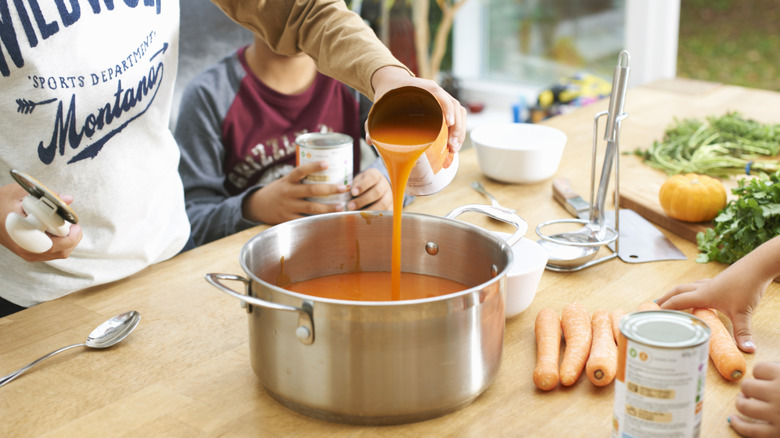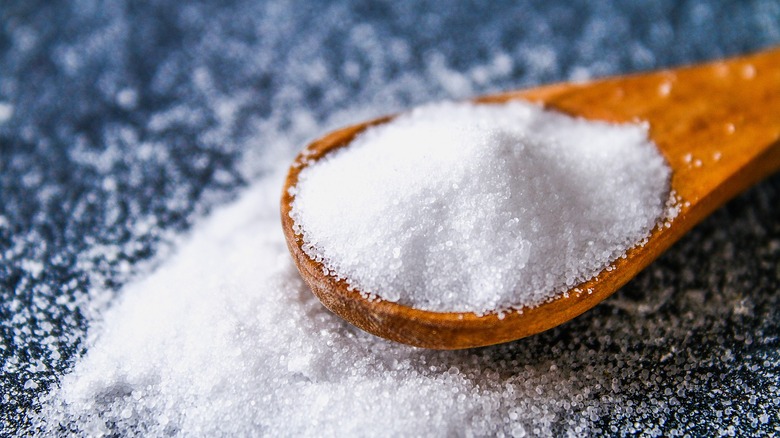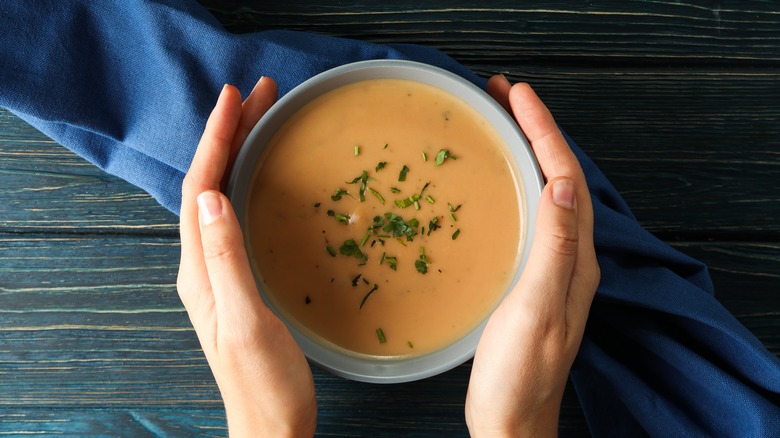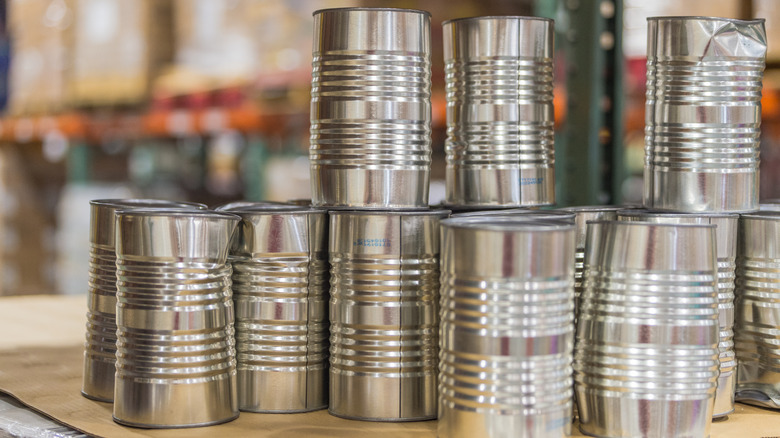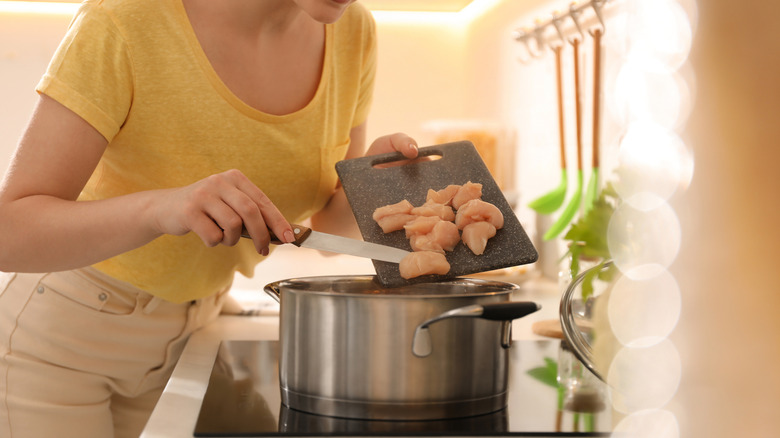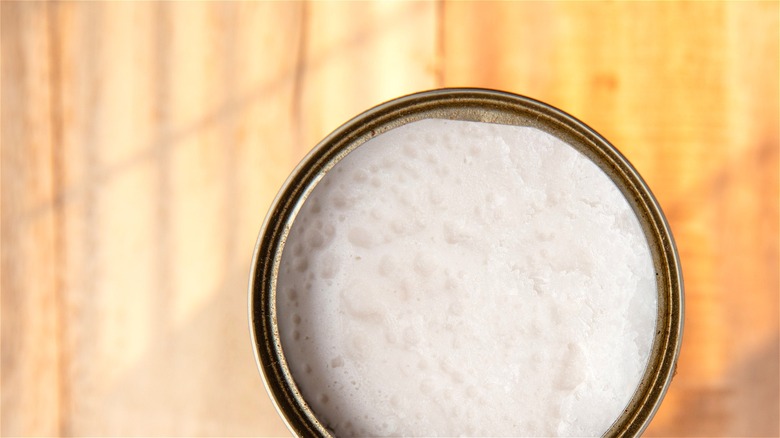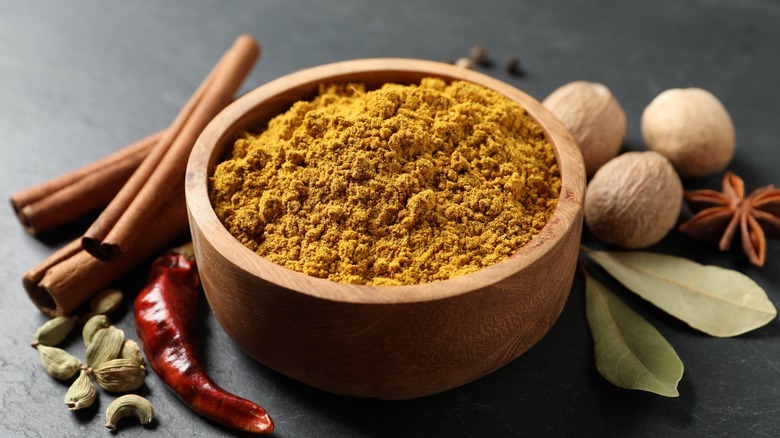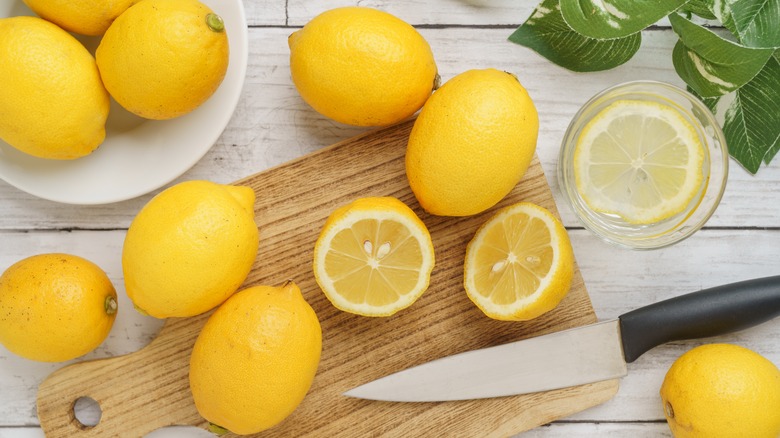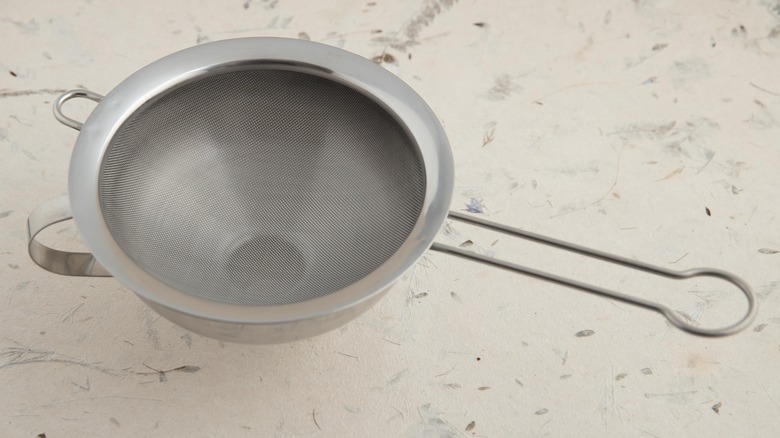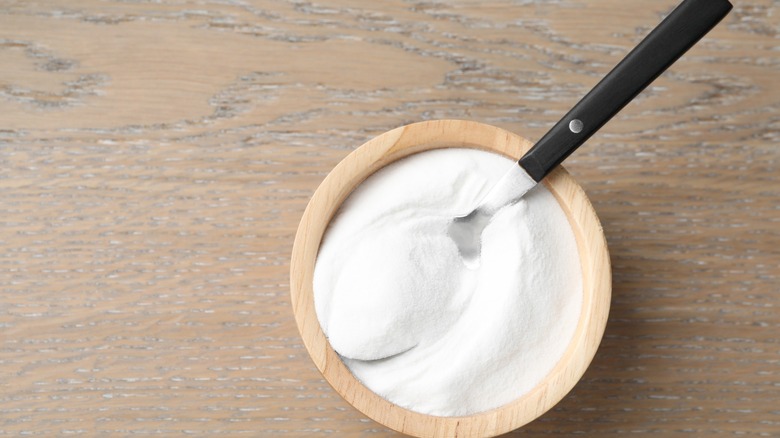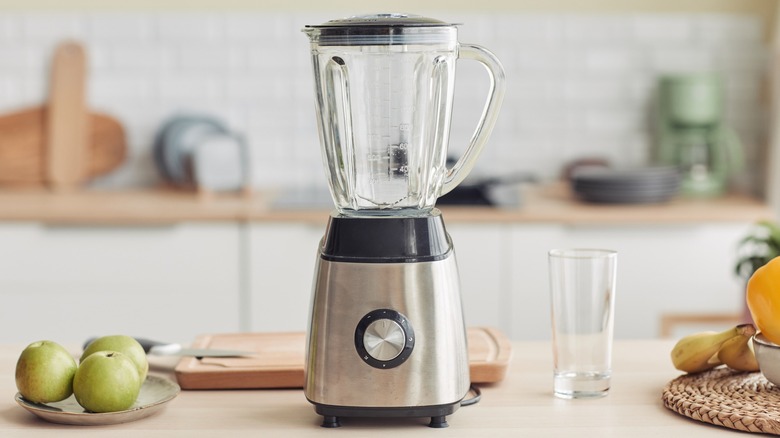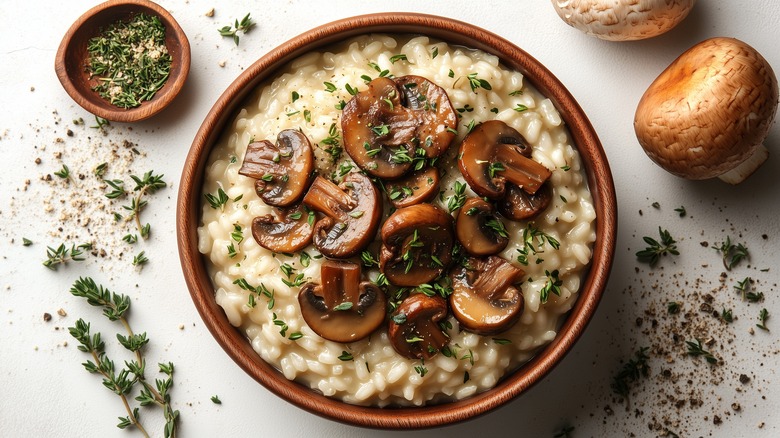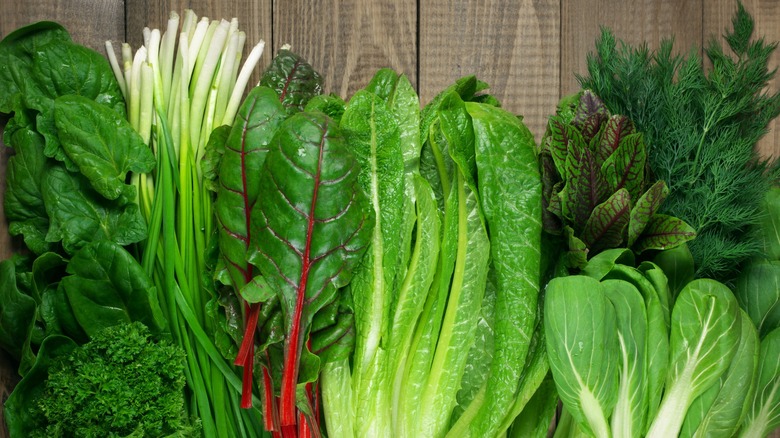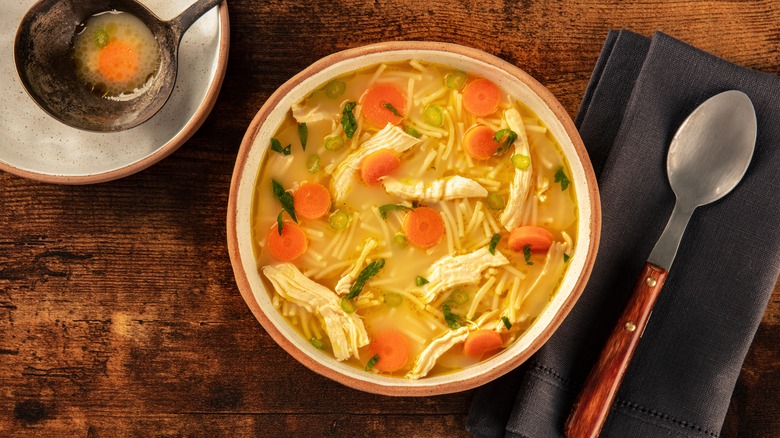14 Big Mistakes You're Probably Making With Canned Soup
Canned soup is the ultimate pantry item. Flavorful, affordable, versatile, and easy to prepare, it's been supplying people with quick lunches and simple dinners since it was invented back in the late 1800s. In all of that time, though, people have been making more mistakes with their canned soup than you might think. This food item isn't as easy to get right as it looks, and it's prone to a wide number of errors when making and consuming it; errors that not only ruin your enjoyment, but may also put you at risk of illness.
A lot of the mistakes surrounding canned soup concern people failing to realize that they can improve it more easily than they think. Some canned soups have an unappealing, one-note flavor that few folks can rectify properly, and some people counteract this by adding ingredients that they really shouldn't. Others forget that canned soup really isn't as substantial as one might think, and they don't add key ingredients that can make it more filling and tasty. One of the most serious mistakes people make, though, is eating canned soup that they really shouldn't, due to compromised packaging. If you're ready to get your canned soup game right, you've come to the right place.
1. Mistake: Adding salt to your canned soup
A lot of canned soups can be curiously lacking in flavor — and we say curiously because, in a lot of cases, we can't quite believe how much sodium they have. There are a lot of canned soups out there that you shouldn't buy, and one of the main reasons you shouldn't buy these is because they can be overloaded with salt, making them totally unhealthy. Weirdly, though, you often can't taste how salty they actually are. People then rectify their lack of flavor by adding even more salt to their soup, turning their dish into a brine bomb that will do you no favors nutrition-wise.
This is why it's vital to check the sodium content of your canned soup before you buy it. Try to avoid brands that have any more than 700 milligrams of sodium per serving, but ideally, you want to aim for way less than that. It can be a good idea to opt for low-sodium and reduced-sodium options where possible. If you've ended up with a high-sodium can of soup that's somehow still tasteless, use spices, herbs, fats, or acids instead to give it flavor, rather than reaching for the salt.
2. Mistake: Forgetting to thin it out
Canned soup has one significant drawback: a too-thick, unsatisfying consistency. Way too often, you'll open a can of soup and find that it's somehow turned into jelly, with a generally lacking consistency (and a taste that's not much better). While this texture can sometimes correct itself when you heat it up, generally, things don't get much appetizing from there.
Well, friends, the solution is simple: Just thin out your soup using a different liquid. Diluting your soup using a low-sodium broth, cream, or even just plain old milk can make its texture way more appealing while also stopping it from tasting overly salty. It's a breeze to do this, too. Once you've decanted your soup, just add a dash or two of your chosen liquid to thin it out, stirring it through before warming things up. Don't be tempted to do this while your soup is still in the can, as it will spill over the edges and cause a big mess in your kitchen. Don't think that using regular broth will be a good idea, either: This will just make your soup way too high in sodium.
3. Mistake: Assuming that your canned soup will be safe to eat
Canned foods have a reputation for being able to last forever, and indeed, they may well last for years after their expiration date. However, the idea that they're always safe to consume is completely false. Any type of canned food can become compromised. When this happens to a canned food, it may cause an incredibly dangerous form of food poisoning.
Canned soups are particularly prone to hosting bacteria that can cause botulism, a dangerous type of food poisoning that can be fatal. This bacteria can make its way into compromised cans that have been pierced or damaged in some way. Generally, you can tell that these cans are damaged by the presence of leaking liquids, rusting, or bulging. Even cans that have small dents around their rim that look merely like cosmetic damage can be very dangerous, and run the risk of making you very sick. If your cans are damaged in any way, it's always best to throw them out. After all, no can of soup is really worth the risk, right?
4. Mistake: Not adding extra protein
Here's the thing about canned soup: It's not going to fill you up very much. There might be the odd brand out there that has a good amount of protein, but generally, canned soups don't offer you a lot of it. Some condensed tomato soups have just a single gram of protein in each serving. When you consider that adults need between 45 to 55 grams of protein daily, that's not going to account for much.
That's why we highly recommend adding extra protein to your canned soups. Not only is this a surefire way to make your meal more substantial, but it also gives your soup way more flavor and more interesting textures, thereby making it more satisfying. If you eat meat, shredded rotisserie chicken or cooked ground beef can be a quick, easy, and cheap way of giving your soup an extra boost. For those people out there following plant-based diets, the solution lies in another can. Pop some drained canned beans into your soup to give it extra protein, a hefty boost of fiber, and some much-needed bite. We guarantee you'll thank us for it.
5. Mistake: Forgetting to add some creamy fats
Canned soups are generally low-fat. Now, this may not be the worst thing in the world, depending on your dietary choices and how the other meals in your day stack up. Unfortunately, though, this lack of fat can leave them feeling a little bit flat, boring, and lacking a smooth mouthfeel.
However, too many people forget that the solution usually lies somewhere in their fridge or pantry. A few splashes of heavy cream, whole milk, or coconut milk can make all the difference in a canned soup. These fats are versatile enough to mesh with most flavors, and they add a richness to the soup that will make it so much more delicious and hearty. Coconut cream can also do the trick: While it's solid in its cold or room temperature form, when it's added to hot soup, it'll melt and diffuse through the broth, giving it a delicious smoothness. If you don't have any creamy fats on hand, a swirl of olive or vegetable oil can also improve canned soup's texture, and give it a lot more heft.
6. Mistake: Not adding spices to your soup
Spices go a long way in canned soup, folks — and yet barely anybody remembers to use them. Instead, they put up with what the manufacturer has decided their soup tastes like, and are disappointed when it doesn't quite hit the spot. Well, next time you open a can of canned soup, open your spice drawer too. Not only do spices give your canned soup extra flavor, but they do so in a way that doesn't raise its sodium levels. Plus, using spices is a superb way of getting rid of that "canned" taste that plagues canned soup, and it also masks the metallic notes that can sometimes seep into the food.
You can use any spices that you like, but it's worth thinking about their individual flavor profiles and how they'll affect your soup. For example, ground cinnamon may not work well in a condensed tomato product, but it may bring a lovely warmth and gentle spice to pumpkin or carrot soups. Paprika, meanwhile, can give chicken noodle or bean soups a smoky undertone, but it may be slightly overpowering in seafood bisques. You don't have to just stick to spices, either: Dried herbs can also give your canned soup a serious flavor boost.
7. Mistake: Skipping a squeeze of lemon
Canned soups can often lack punchy flavor, and it can be tricky to know how to bring them back to life. Luckily, the solution might be sitting in your fruit bowl. A squeeze of lemon is a quick fix for canned soup that most people don't consider, but can make an enormous difference. The acidity of lemon juice can act as a flavor enhancer, while simultaneously helping to balance out any overly salty notes in your soup. It can also help to level things out if your canned soup has too much sweetness.
If you don't have any lemons on hand, never fear: Basically any acid can make your soup better. Lime juice is the most obvious alternative, but white wine and rice vinegars will also balance your soup effectively without adding too many other flavors into the mix. A dash of balsamic vinegar, meanwhile, can add both acidity and some fruity notes that can make your soup taste even deeper. When adding any acid, just be wary of squeezing or pouring in too much, as this will ruin your meal.
8. Mistake: Failing to strain your soup
The nature of canned soup is simple. You just open the can, pour it into a bowl, and you're good to go. Well, what if we told you that there's a canned soup straining trick that barely anyone is doing, but which will make your soup even better? All you need is your regular kitchen strainer, two cans of soup, and two bowls. You first open one can of soup, and strain it into the first bowl, collecting its solid ingredients in the strainer. Decant the second can of soup into the second bowl, and then add the solids into that bowl too. Voila! You'll have a chunky, flavorful soup that has way more nutrients.
Naturally, this hack only works if you're using chunky soups. Straining smooth soups will have very little effect, as they'll just pour straight through into the bowl. As for the strained liquid, don't throw that away. You can reserve or freeze it to use in future dishes, giving things like pasta sauces or stews more flavor. You can also add it to a soup of your own making, to improve its broth.
9. Mistake: Not adding a pinch of baking soda
One of the most unpleasant flavor notes in canned soups is metal, and it shows up in a lot of products. Like it or not, your soup is sitting in a metal can, and while some soups can resist taking on metallic notes, not all of them are so lucky. The biggest mistake people make with these flavor notes is just putting up with them, and assuming that it's just a part of canned soup. Thankfully, a pinch of baking soda can wipe these metallic flavor notes away almost instantly.
Metallic tastes in soups often come from a higher level of acidity, and they're especially present in tomato-based soups. This is because more acidic soups can react with the metal in the can, causing its flavor to work its way into the liquid. Baking soda can help to neutralize these acids and the flavors they cause. Having said this, it's very easy to go overboard with baking soda, which will give your soup a soapy flavor. A ¼ teaspoon should do the trick; stir it in well before heating your soup through and serving it.
10. Mistake: Forgetting to purée part of your soup
Canned soup can be a meal of two halves. All too often, you end up with a product that has a water-thin broth and is full of chunky, slightly chalky vegetables. This combination doesn't exactly make for satisfying eating — but people just kinda put up with it, instead of considering that there's a solution out there that comes in the form of a blender.
Puréeing part of your soup can fix its texture instantly. By decanting half of the soup into a blender and whirring it up, you create a smoother, thicker base for the chunkier ingredients to swim in. This gives your soup greater cohesion and stops the broth from being thin and runny. It can also help to bring the soup's flavors together more effectively. Blending your soup is also a great way to fix its entire texture, especially if you've ended up with a gloopy can of soup that feels heavy. By puréeing it, you make things so much smoother. If things get too thick when you're puréeing, just add a dash of water or low-sodium broth.
11. Mistake: Not using canned soup in recipes
People can be really boring with their canned soup, y'all. They just open it, dump it in a bowl, and eat it. Now, we know that's how they were designed to be consumed, but come on — we can do a lot better than that. The truth is that canned soups are incredibly versatile ingredients for bigger recipes, and failing to use them means that you're failing to take advantage of a time-saving kitchen hack that may provide flavor in a more cost-effective way than buying a million different ingredients.
Canned soup can go into different pasta dishes effortlessly – and you're not limited to using just tomato soup. You can use mushroom soup for spaghetti sauce, cream of chicken soup for carbonara, or clam chowder to make seafood linguine. If it's rice that you're hankering for, you can use canned soup to make the easiest risotto known to man. You can even pop canned soup into a pot roast to give it a huge amount of flavor and a more velvety, smooth texture. All you need to do in all of these cases is open a can and pour. That's our kind of cooking.
12. Mistake: Skipping your greens
Did your mom tell you that you had to get your greens when you were younger? Well, we're going to do exactly the same thing, especially if you're eating canned soup. Unfortunately, way too many people forget that greens are one of the best additions you can make to canned soup, and they do more than just boost its nutritional levels (although that is, of course, very welcome). Greens also stretch out your canned soup, giving you more for your money, and add a nutty, earthy note that can counteract the salty flavors of soup excellently.
The greens you choose are entirely up to you, but we'd be lying if we said we didn't have a few favorites. Spinach is our go-to for canned soup, thanks to its ability to wilt quickly, and its easy yet rich flavor. Kale is another excellent choice, and can give your canned soup a touch more earthiness — just make sure you cook it for long enough so that it softens properly. Arugula can also give canned soup a burst of peppery flavors, and when it's scattered on top as a garnish it also provides a delightful crunch.
13. Mistake: Assuming you can only eat it for lunch
Canned soup is a lunchtime staple, and for good reason. It transports well to the office, it takes a few minutes to prepare from start to finish, and you only need to wash up a bowl afterward. Now, that's all well and good, but if you're only eating canned soup for lunch, you're missing out on a lot of possibilities. Not only can canned soup be used in a load of dinner dishes, but it can also be used in your morning meal. That's right: Canned soup for breakfast is a thing, and it works pretty well.
Canned soup is surprisingly satisfying for breakfast, at a time of the day when you want something warming and filling, but not necessarily heavy. You can also jazz it up to make it more breakfast-focused. Try making a form of egg drop soup with canned chicken noodle soup, cracking and whisking eggs into it — and then scattering cooked bacon pieces on top. Serve it with a slice of sourdough bread, and you'll be in heaven. Alternatively, you can use condensed tomato soup to make a form of shakshouka. Just replace your regular canned tomatoes with the soup, crack your eggs into it, and simmer.
14. Mistake: Not bulking it up with some carbs
Canned soup is one of those meals that can pass through you in an instant. You wolf it down, and half an hour later, you're feeling hungry and de-energized. A lot of people just accept this as an unfortunate truth of canned soup, but by adding some pasta to your dish you can make things pretty hearty.
You simply need to cook your pasta of choice, and then stir it through your soup. It's always wise to go for smaller pasta shapes when doing this. Long, thin pastas like linguine or spaghetti will be way too cumbersome to pick up with a spoon, and you'll just end up splashing your soup everywhere. If you don't want to use up another pan to cook your pasta, you can also cook the pasta directly in the soup itself. Just bring it to a simmer on the stove, drop your pasta in, and boil until the pasta's tender. Remember, though, that doing this will cause your soup to thicken considerably as the pasta releases starch into the soup.
